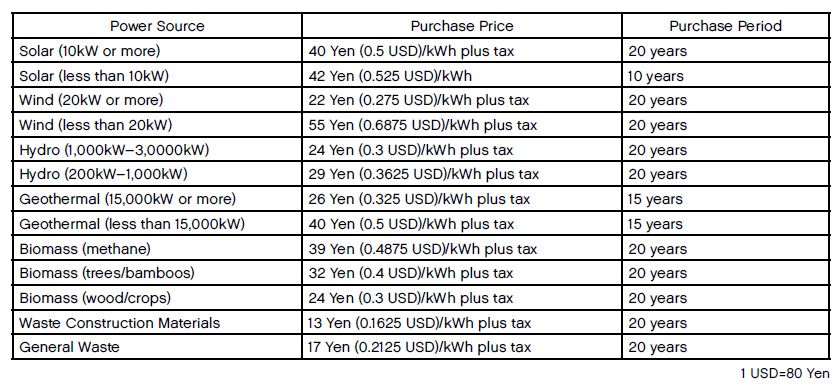- within Accounting and Audit and Strategy topic(s)
Effective July 1, 2012, Japan implemented a new feed-in tariff ("FIT") system under the Act on Special Measures Concerning the Procurement of Renewable Energy by Operators of Electric Utilities (the "Act"). Under the terms of the FIT system, power utilities must purchase electricity from applicable renewable energy sources, including solar, wind, hydro, geothermal, biomass, and others, generated by certified power generating facilities (the "Certified Facilities") at a fixed price (the "Purchase Price") for a given period (the "Purchase Period"). This Commentary provides an overview of the FIT system with specific focus on key items stipulated in the newly promulgated ordinance for the Act (the "Ordinance").
Purchase Price and Purchase Period
The Ministry of Economy, Trade and Industry ("METI") has set the Purchase Price and the Purchase Period for the mandatory purchase of power generated by renewable energy sources under the FIT system for fiscal year 2012. The initial Purchase Price and the Purchase Period apply to a renewable energy project if (1) a power utility receives a written request from the generator for connection of a Certified Facility to the power utility's transmission facility and a power generating facility is certified as a Certified Facility and (2) the date of such request or certification (whichever is later) falls between July 1, 2012 and March 31, 2013. The Purchase Period starts from the date renewable energy supply commences to the power utility. The following chart sets forth the initial Purchase Price and Purchase Period for each type of renewable energy subject to the FIT system:

METI designed the Purchase Price and the Purchase Period for each type of renewable energy with the goal of providing sufficient incentives for new investments in renewable energy projects. Although METI fixed the Purchase Price for the applicable Purchase Period, it retains authority to revise the Purchase Price during that period if required by a significant change in prices and other economic factors, in accordance with the opinion of a third-party committee of experts and subject to reporting the basis of the calculation of the revised prices to the Diet.
Following the initial Purchase Period, METI must determine the Purchase Price and Purchase Period annually, subject to reporting the basis for its calculations to the Diet. Purchase Price determinations must be based primarily on (1) costs generally incurred for the efficient supply of renewable energy; and (2) appropriate level of profits for the generators of renewable energy. One of the reasons that the Purchase Price for each type of renewable energy source that has been set for fiscal year 2012 is high is that the cost of implementing a renewable energy project in Japan remains relatively high as compared to that in other jurisdictions such as Germany. In order to boost the expansion of renewable energy, the Ordinance permits special consideration during the first three fiscal years starting from the 2012 fiscal year to the appropriate level of profits for power generators when determining the Purchase Price.
While consumer electricity surcharges fund the FIT system, periodic adjustments of the Purchase Price to reflect actual costs, which may drop sharply, are intended to balance the goal of expanding the use of renewable energy and the burden to the electricity consumers in order to sustain the FIT system efficiently. In this regard, the Ordinance requires that power generators (1) report installation costs upon the commencement of the electricity supply and (2) report annual operating costs of the Certified Facility once a year so that the actual costs can be reflected in the determination of the Purchase Price for the following year. Ultimately, the Act requires review of its implementation by the Japanese Government by March 31, 2021.
Facility Certification
A power generating facility must qualify as a Certified Facility for eligibility under the FIT system. According to METI, facility certification takes approximately one month (or two months in the case of biomass facilities). The Ordinance requires that Certified Facilities implement a domestic maintenance and repair system for the duration of the Purchase Period, capable of starting repair work within three months after repairs become necessary. If the maintenance and repair system becomes unavailable during the Purchase Period, due to the bankruptcy of the manufacturer of a Certified Facility, for example, METI may revoke certification unless the generator or other third party implements a replacement maintenance and repair system.
Power Supply Agreement
The Act requires that power utilities requested by a power generator enter into an agreement on the supply and purchase of power generated by a Certified Facility, unless a statutory exemption applies. This obligation of the power utility applies to any request from a generator's Certified Facility. Valid exemptions under the Act include: (1) instances where the agreement includes false or illegal content or obligates the utility to compensate for damages not attributable to it or damages in excess of the amount resulting from its breach of its contractual obligations and (2) instances where the generator does not accept certain terms in the agreement, including (among other things) payment terms, jurisdiction (Japanese courts), and governing law (Japanese law). In addition, if the utility requested to enter into the agreement differs from the utility providing the related power connection, the requested utility may refuse by providing reasonable evidence that geographic reasons make it impossible for the former to access the power supply from the renewable energy source.
Power Connection Agreement
Similarly, the Act and the Ordinance require a power utility requested by a power generator to connect the Certified Facility to the utility's transmission facility, unless an exemption exists. Valid exemptions under the Act include: (1) instances where the generator does not bear certain costs necessary for the connection specified in the Ordinance or where the connection interferes with the utility's smooth supply of electricity, (2) instances where the generator does not provide information necessary for the connection or where the agreement includes false or illegal content or obligates the utility to compensate for damages not attributable to it or damages in excess of the amount resulting from its breach of its contractual obligations, and (3) instances where the generator does not accept certain terms in the agreement, including (among other things) the restraint of power output without compensation under certain circumstances and compensation terms for the restraint of power generally. In addition, where allowing connection is reasonably expected to exceed the utility's transmission capacity or receptive capacity, the utility may refuse to enter into the agreement by providing reasonable evidence and alternative connecting points financially reasonable for the generator in the case of excess transmission.
Restraint of Power Output
Although the Ordinance sets no limit on the total amount of power required to be purchased by power utilities from Certified Facilities under the FIT system, in certain circumstances specified in the Ordinance, the power generator must restrain its power output in accordance with the power utility's instruction. For instance, the generator must restrain its power output without compensation (1) if the supply of power estimates exceed demand, despite certain countermeasures by the utility, including the restraint of power output by the utility (as long as such restriction is not imposed for more than 30 days per year); (2) in cases of a breakdown or suspension of the utility's facility resulting from force majeure, or intrusion by a third party or a movable not attributable to the utility; or (3) in case of inspection, repair, or connecting work on the utility's facility. When imposing any restraint on power output for any of the foregoing reasons, the utility must provide reasonable evidence for the basis of its request. For any other restraint of power output imposed by the utility, the generator may claim compensation for damages resulting from the restraint.
Further Challenges
Japan recognizes that the promotion of renewable energy also requires further deregulation to eliminate or minimize time-consuming and cumbersome requirements that create disincentives for developing renewable energy projects. In April 2012, the Japanese Government adopted a plan for deregulation in the energy sector, listing 103 items for deregulation or reform to promote renewable energy. The Japanese Government has proceeded with this deregulation in accordance with the plan, through (among others) the following actions:
- The government amended the Factory Location Act abolishing area-to-land ratio restrictions and filing obligations for large-scale solar power facilities.
- The government revised restrictions on drilling in national parks to facilitate drilling for geothermal energy sources.
- A new bill promoting the generation of renewable energy in agricultural, forestry, and fishery areas submitted in the current Diet session streamlines procedures and requirements for obtaining authorization required under laws restricting the use of agricultural, forestry, and coastal land, fishing ports, and grounds.
- An expected simplification and shortening of the procedures and requirements for environmental assessments required for wind power.
- An expected revision of required standards for wind power facilities under the Building Standards Act.
Japan's promotion of renewable energy faces a bigger challenge around the enhancement of its power grids. In order to cope with unstable power output from renewable energy sources such as solar power and wind power, Japan adopted policies to enhance transmission grids and storage facilities. Further, because areas suitable for power generation from renewable energy sources such as wind power are geographically limited (located mostly in the Hokkaido and Tohoku regions) and are remote from large consuming urban centers (such as Tokyo and Osaka), Japan's grid requires significant expansion to accommodate the plans. Given the large capital expenditures required and Japan's division into 10 regions for power generation and transmission, with each region controlled by a regional power utility that enjoys a monopoly, the grid initiative requires strong governmental leadership for the development of extensive cross-regional grids. METI recently announced a plan promoting grid enhancement through governmental financial support, with areas such as the Hokkaido and Tohoku regions designated as a priority for wind power generation. METI is seeking an acceleration of grid enhancement through cooperation among the Japanese Government, power utilities, and wind power generators.
In a final recent development, the Japanese Government adopted a "green" innovation strategy setting priorities including new energy control systems (such as smart communities), storage batteries, ocean development (including offshore wind power), and "green" materials (including materials for wind power facilities). This newly developed "green" innovation strategy, together with the implementation of the FIT system, are expected to be a driving force in the revitalization of the Japanese economy.
Conclusion
The FIT system reflects the Japanese Government's desire rapidly to expand the renewable energy sector, especially in light of the current uncertainty over the future of nuclear power in Japan. The Purchase Price and Purchase Period that have been set for each type of eligible renewable energy source for fiscal year 2012 suggest that the FIT system is one of the most attractive feed-in tariff systems in the world for power producers. At the same time, in order to ensure that the FIT system can be effectively and efficiently implemented and benefit both the power producers and consumers, the Japanese Government actively must address a number of challenges through deregulation to facilitate the development of renewable energy projects and enhancement of the power grids to enable extensive crossregional power transmission within Japan.
The content of this article is intended to provide a general guide to the subject matter. Specialist advice should be sought about your specific circumstances.



